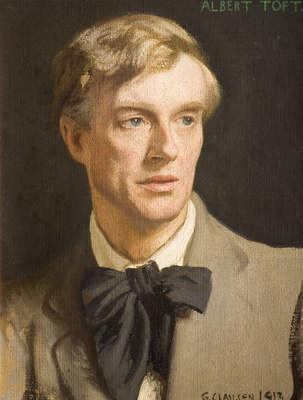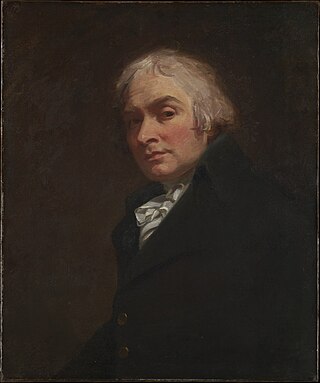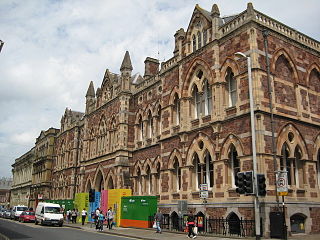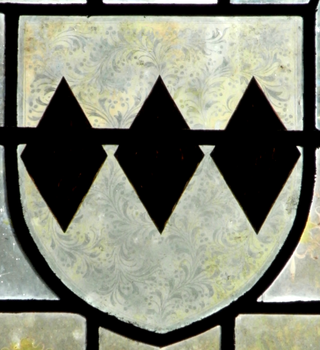Related Research Articles

Sir John Everett Millais, 1st Baronet was an English painter and illustrator who was one of the founders of the Pre-Raphaelite Brotherhood. He was a child prodigy who, aged eleven, became the youngest student to enter the Royal Academy Schools. The Pre-Raphaelite Brotherhood was founded at his family home in London, at 83 Gower Street. Millais became the most famous exponent of the style, his painting Christ in the House of His Parents (1849–50) generating considerable controversy, and he produced a picture that could serve as the embodiment of the historical and naturalist focus of the group, Ophelia, in 1851–52.

John William Waterhouse was an English painter known for working first in the Academic style and for then embracing the Pre-Raphaelite Brotherhood's style and subject matter. His paintings are known for their depictions of women from both ancient Greek mythology and Arthurian legend. A high proportion depict a single young and beautiful woman in a historical costume and setting, though there are some ventures into Orientalist painting and genre painting, still mostly featuring women.

Sir William Hamo Thornycroft was an English sculptor, responsible for some of London's best-known statues, including the statue of Oliver Cromwell outside the Palace of Westminster. He was a keen student of classical sculpture and was one of the youngest artists to be elected to the Royal Academy, in 1882, the same year the bronze cast of Teucer was purchased for the British nation under the auspices of the Chantrey Bequest.

Albert Toft was a British sculptor.

George Romney was an English portrait painter. He was the most fashionable artist of his day, painting many leading society figures – including his artistic muse, Emma Hamilton, mistress of Lord Nelson.

George Wesley Bellows was an American realist painter, known for his bold depictions of urban life in New York City. He became, according to the Columbus Museum of Art, "the most acclaimed American artist of his generation".

Francis Bedford was one of England's most prominent landscape photographers and the first to accompany a royal tour.

Thomas Luny (1759–1837), was an English artist who primarily painted seascapes and other marine-based works.

Royal Albert Memorial Museum & Art Gallery (RAMM) is a museum and art gallery in Exeter, Devon, the largest in the city. It holds significant and diverse collections in areas such as zoology, anthropology, fine art, local and foreign archaeology and geology.
Elaine M. Goodwin is a British artist and author. She has exhibited extensively, written several works on art and design, and was founder president of the British Association of Modern Mosaics (BAMM). Together with other prominent artists, Goodwin also co-founded Tessellated Expression for the 21st Century (TE-21), a group of professional artists dedicated to exhibitions of the tessellated art form.
John Maltby was a distinguished English sculptor and studio potter.
Amelia Griffiths (1768–1858), often referred to in contemporary works as Mrs Griffiths of Torquay, was a beachcomber and amateur phycologist who made many important collections of marine algae specimens.

Harry Hems was an English architectural and ecclesiastical sculptor who was particularly inspired by Gothic architecture and a practitioner of Gothic Revival. He founded and ran a large workshop in Exeter, Devon, which produced woodwork and sculpture for churches all over the country and abroad. He was also a philanthropist and an eager self-promoter. A large part of the collection of medieval woodwork that he accumulated during his working life is now in the Royal Albert Memorial Museum in Exeter.

Edward Bowring Stephens, was a British sculptor from Devon. He was honorary secretary of the Institute of Sculptors circa 1861.

Marian Emma Chase (1844–1905) was a British painter, water colour artist and draftsperson. She is best known for her flower, fruit and still-life watercolour paintings. The Victoria and Albert Museum holds one of her works.

Martha Darley Mutrie was a British painter. Her paintings consisted mostly of fruit and flowers. She grew up in Manchester, England, and studied at the Manchester School of Design. Mutrie's works were shown at the Royal Academy of Arts, Royal Manchester Institution and other national and international exhibitions. Her works are among the collections of the Victoria and Albert Museum and the Russell-Cotes Art Gallery & Museum.

John Tuckfield of the City of Exeter, Devon, was a merchant, Alderman of Exeter, and member of the Company of Merchant Adventurers of Exeter who was Sheriff of Exeter in 1547 and Mayor of Exeter in 1549–1550.

Constance Sladen was an artist, architectural historian, and philanthropist who was one of the first female members of the Linnean Society of London and founded the Percy Sladen Memorial Trust in memory of her late husband.

Ann Lee was a British botanical illustrator who also illustrated birds and insects.

William John Seward Webber was an English sculptor who created civic statuary, and busts of national heroes and local worthies, in marble. He sculpted the statue of Queen Victoria for the Jubilee Monument in Harrogate, North Riding of Yorkshire, England in 1887. An early success was his Warrior and Wounded Youth group of 1878, executed while he was still a student. His busts include portraits of the Duke of Clarence, John Charles Dollman, Henry Phillpotts, John Bowring, John Ruskin, Richard Jefferies, Alfred, Lord Tennyson, Charles Darwin, Walter Scott, Thomas Carlyle, Robert Burns and Thomas Holroyd.
References
- ↑ "1851 Census England & Wales". www.linter.co.uk. Retrieved 14 April 2021.
- 1 2 3 4 5 6 Oliver, P. Graham; Morgenroth, Holly (21 May 2018). "Additional type and other notable specimens of Mollusca from the Montagu Collection in the Royal Albert Memorial Museum & Art Gallery, Exeter". Zoosystematics and Evolution. 94 (2): 281–303. doi: 10.3897/zse.94.24776 . ISSN 1860-0743.
- 1 2 "William Brine Linter 1811-1892". www.linter.co.uk. Retrieved 14 April 2021.
- ↑ "Juliana Emma Linter (1844–1909)". Royal Albert Memorial Museum & Art Gallery, Exeter. Retrieved 14 April 2021.